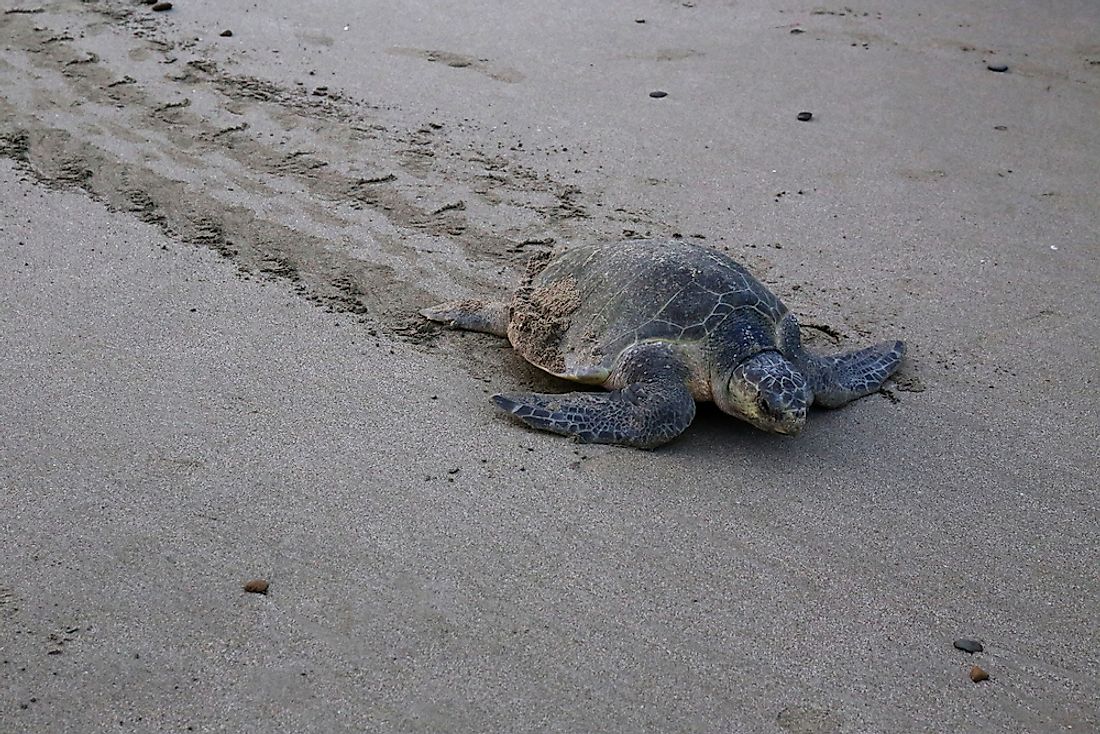Olive Ridley Sea Turtle Facts: Animals of North America

5. Physical Description
Olive Ridley sea turtles (Lepidochelys olivacea), so named for their olive-colored, heart-shaped carapaces (shells), are among the smallest marine turtle species in the world. Adults of this species measure about 2-2.5 feet (62-70 cm) in length, and only weigh up to 100 pounds (45 kilograms) . The carapaces of Olive Ridley Turtles bear variable number of scutes (scales), both vertebral and costal, which are one of the unique identifying features of this species. 1 or 2 of the turtle's claws peep out of their front and rear flippers. When young, the turtles are charcoal grey in color, which transforms to their signature olive green color by the time they reach adulthood.
4. Diet
Olive Ridley sea turtles are predominantly carnivorous in nature, foraging the shallow marine waters for invertebrate prey, including jellyfish, sea urchins, snails, crabs, and lobsters. Consumption of certain species of adult fish and fish eggs have also been observed. In areas where these prey sources are less abundant, the turtles often supplement their diet with filamentous algae. Another interesting, but rare, feeding behaviour exhibited by Olive Ridley turtles in captivity is that of cannibalism. The frequency of occurrence of this phenomenon in natural habitats has yet to be investigated.
3. Habitat and Range
The Olive Ridley sea turtles are primarily pelagic foragers who migrate annually to coastal areas for breeding and nesting. The warm, sub-tropical and tropical waters of the South Atlantic, South Pacific and Indian Oceans all serve as suitable habitats for this unique species of turtle. The turtles roost and forage in the marine waters off the northern coasts of South America, southeast Asia, Australia and the Indian subcontinent. The species also thrives in the waters along the Western Pacific coasts of the Americas, from Canada in the north to Peru in the south. The natural predators of the adult turtles are few, and mainly include large sharks and predatory whales. However, the eggs and hatchlings are highly susceptible to a large variety of predators, including a range of terrestrial, aquatic, and airborne creatures alike. Even though the Olive Ridley sea turtles are the most abundant marine turtle species in the world, over recent years their numbers have fast dwindled due to overexploitation. According to recent estimates, there are roughly about 800,000 nesting females of this species to be found worldwide, and these numbers are thought to be decreasing further still. The Olive Ridley turtles are marked as "Vulnerable" in the IUCN Red List of Threatened Species. The slaughtering of nesting females for meat, harvesting of turtle eggs for human consumption, degradation of nesting beaches due to coastal developmental activities, and, of course, the death of turtles caught as bycatch associated with irresponsible fishing practices, are the prevailing factors threatening the well-being of the Olive Ridleys.
2. Behavior
One of the most striking behavioral characteristics of the Olive Ridley turtles are their mass migrations to the shores for nesting. This phenomenon is referred to as ‘arribada’ (Spanish for ‘mass migration) and involves the gathering of thousands of females offshore of nesting beaches, and their synchronous migration to the shores to lay eggs. Often, the high density and sheer numbers of females migrating to the same beach for nesting results in females climbing over each other’s backs or digging up existing nests to lay their own eggs. There are a number of theories suggested to explain this distinctive behavior of the turtles, such as the secretion of female pheromones, lunar cycles, and wind directions. However, scientists need to conduct further studies to arrive at a conclusive answer. When the Olive Ridleys are not nesting, they spend a great deal of time foraging the marine waters in search of prey, sometimes as deep as 328 feet (100 m) below sea level. The harvesting of these turtles by marine trawlers from such depths are proof of this fact. In cooler waters of the oceans, Olive Ridleys can occasionally be spotted on the water surface, basking themselves in the sun. This behavior, however, is absent in the warmer waters.
1. Reproduction
During the mating season, both male and female Olive Ridleys migrate from their marine feeding grounds towards the shorelines. Even though mating is thought to occur primarily in the marine waters near the nesting beaches, accounts of pairs of Olive Ridleys copulating as far as 1000 kilometers away from the nesting beach also have been report. As mentioned earlier, mating is followed by the remarkable phenomenon of arribada, which has enthralled scientists and naturalists for a long time, and continues to do so today. Each female lays around 2 to 3 clutches of eggs per nesting season, with each clutch in turn yielding between 110 and 120 eggs. The incubation period for the eggs lasts about 45 to 60 days, after which time the hatchlings emerge and make their entry into the sea waters. Sex determination in Olive Ridleys is based on incubation temperature. Temperatures of lower than 28°C (82°F) produces males, conditions of 29 to 30 °C (84-86°F) produces a mixed clutch of males and females, while temperatures of 31 to 32°C (88-90°F) will produce solely females.











